


JAN VAN EYCK c1390 -
xxxxxThe Flemish artist Jan van Eyck, one of the first painters to use oils, was a miniaturist by training. This accounts for his attention to detail, and the brilliance of his colouring. After some experimenting, he obtained a high gloss effect by applying a series of thin glazes. His themes were generally biblical, but he did paint a number of portraits. His masterpiece is considered to be his The Adoration of the Lamb, an inner panel of an altarpiece he painted for Saint Bavo Cathedral in Ghent in 1432. A number of his works are in the National Gallery in London, including Man with a Turban of 1433, possibly a self-
Including:
Rogier van
der Weyden
and Konrad Witz

aaaaaThe Flemish artist Jan van Eyck was one of the first painters to use oil paint successfully, and this was a major break-
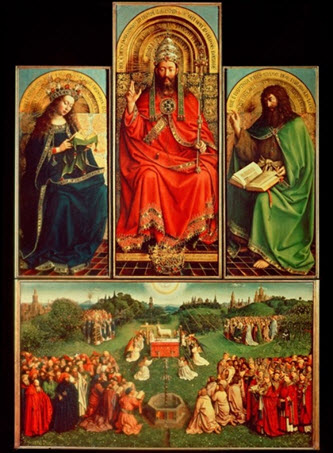
aaaaaOil painting was already in existence at this time, known as the egg-
aaaaaHis subject matter was generally biblical and, as he regarded God and nature as one, there is a great deal of religious symbolism in his work. In addition, however, he was among the earliest artists to paint portraits, and his work in this field has also been much admired. He was probably born in Maaseik, and he worked in The Hague as a miniaturist for over three years before entering the service of the powerful Duke of Burgundy.
aaaaaHere, as well as the court painter, he worked as a diplomat, sometimes on secret missions. In 1428 he combined his two offices when he went on a visit to Portugal to paint the king’s daughter, Isabella, so that the Duke could see what she looked like before committing himself to marriage! The Duke studied the portrait and agreed to marry the Princess.
aaaaaEyck set up home in Bruges around 1430, and was soon in demand as a portrait painter by the wealthy merchants and town notables. Among his portraits were the Madonna with Chancellor Rolin and the Madonna with Canon van der Paele. Also of this period is the altarpiece which includes the inner panel The Adoration of the Lamb, probably completed around 1432 and considered to be his masterpiece (illustrated above). The altarpiece was commissioned for Saint Bavo cathedral in Ghent, and it is possible that Hubert -
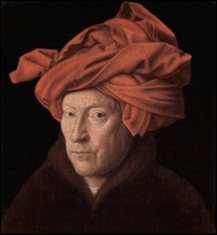
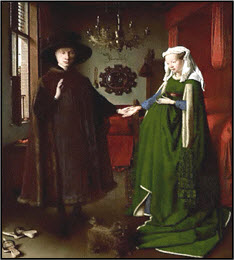 aaaaaThere are a number of works by Jan van Eyck in the National Gallery, London. Illustrated here are the Man with a Turban (1433) -
aaaaaThere are a number of works by Jan van Eyck in the National Gallery, London. Illustrated here are the Man with a Turban (1433) -
xxxxxThe artist Rogier van der Weyden (c1399-
aaaaaThe artist Rogier van der Weyden (c1399-
aaaaaLike Eyck, most of his work is confined to altarpieces, but he did produce some small icons of Christ and the Virgin and Child, as well as a number of fine portraits. His work is elegantly simple in composition, and his detailed figures are sensitively portrayed. A deeply religious intensity pervades his work, and this is particularly so in his Annunciation (now in the Prado, Madrid) and his three versions of the crucifixion (one illustrated below).
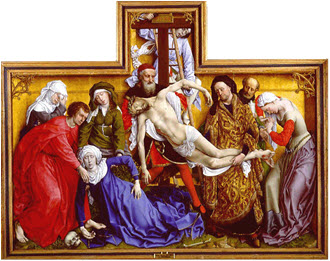 aaaaaHis Descent from the Cross (The Deposition) painted around 1435 -
aaaaaHis Descent from the Cross (The Deposition) painted around 1435 -
aaaaaIn 1450 he paid a visit to Rome and was very well received. While in Italy, he demonstrated the technique of painting in oils, and gained commissions from the wealthy Este family of Ferrara and the Medici of Florence. His Madonna and Child, now in the Uffizi museum, was commissioned by the Medici. After his visit to Italy his style did become softer in tone and more natural in form, as can be seen in his Adoration of the Magi, but he still remained intent on a rather iconic approach.



Acknowledgements
Jan Van Eyck: Adoration of the Lamb – St. Bavo’s Cathedral, Ghent; Man in turban – National Gallery, London; Giovanni Arnolfini and his wife – National Gallery, London; Virgin Mary – St. Bavo’s Cathedral, Ghent; The Annunciation (detail) – National Gallery of Art, Washington; Portrait of Christ – Groeningemuseum, Bruges; Artist’s wife – Stedelijk Museum, Bruges. Weydon: Descent from Cross – Museo del Prado, Madrid; Adoration of the Magi – Alte Pinakothek, Munich; Crucifixion Triptych – Kunsthistoriches Museum, Vienna; St.Luke drawing a portrait of the Virgin Mary – Museum of Fine Arts, Boston; Witz: The Miraculous Draught – Musee d’Art et d’Histoire, Geneva.
H6-
aaaaaIncidentally, such was the esteem in which his work was held, that at the Treaty of Versailles, the peace settlement which followed the end the First World War (1914-
Left to Right: Adoration of the Magi, Crucifixion, and Saint Luke painting the Virgin.
aaaaaWeyden ended his days as a wealthy and famous artist, with a large workshop, numerous pupils and a constant flow of commissions. His work had a marked influence on later Flemish painters, such as Dirck Bouts and Hans Memling, and it was also felt in the artistic circles of Germany, France, Italy 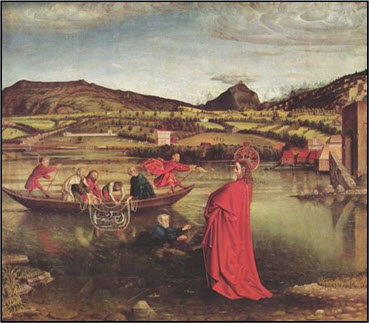 and Spain.
and Spain.
aaaaaDeserving a mention here is the German-

